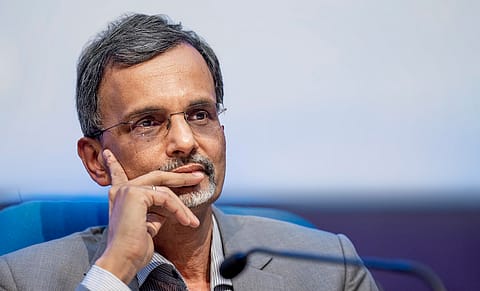India's growth story intact, need to pull all levers: CEA
On the food inflation front, Nageswaran reiterated that specific food items are contributing to the sharp rise in inflation

Chief Economic Adviser (CEA) V. Anantha Nageswaran on Thursday stated that India’s growth story is intact. The CEA said that the global environment is less conducive and India needs to pull all domestic levers of growth.
“In reacting to the Q2 GDP growth numbers, we should not throw the baby out with the bathwater because the underlying growth story remains very much intact. India’s capital formation — investments by businesses, governments and public enterprises—was 27.3% of the GDP by the end of the second decade and now it has improved to 30.8%. Exports have also picked up in this very challenging global environment. If you take services and manufacturing together, India’s total exports as a percentage of its GDP are higher than China,” Nageswaran said at Assocham’s Bharat@100 Summit.
On the food inflation front, Nageswaran reiterated that specific food items are contributing to the sharp rise in inflation, but it is confined to a very small percentage of the overall consumer price index basket of goods and services.
“India’s underlining growth story is intact. This is important as the country aspires to be a developed nation at a time when the global economic and political uncertainty poses a challenge. In contrast, East Asian economies had it easier when they charted their growth in a largely bipolar world,” Nageswaran added.
He added that the policy reforms over the past decade have begun to bear fruit. “Unlike past cycles of growth, India has been able to sustain its economic trajectory because of supply-side improvements that kept pace with demand growth,” the CEA said, mentioning about the vast improvements in logistics space, India’s substantive jump in the global innovation index, the rapid financial coverage under PMJDY (Pradhan Mantri Jan Dhan Yojana), and the better outcomes in education.
Noting that corporate profitability reached a 15-year high in FY24, Nageswaran said that a large part of this income is being diverted by companies to reduce their leverage. “While it is good to improve balance sheets, corporate profitability and workers’ income growth has to be balanced,” he said.
Nageswaran noted that prioritising technical education and skilling, especially for women, along with de-regulation and greater quality controls, are instrumental for India’s path to a developed economy. “Since India must increasingly depend on domestic growth for the next decade or two, all stakeholders — the public sector, private sector, and academia — must collaborate to make the vision of Viksit Bharat a reality,” Nageswaran added.